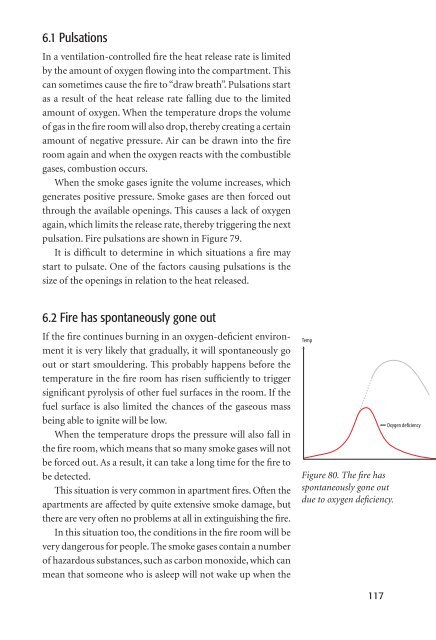You also want an ePaper? Increase the reach of your titles
YUMPU automatically turns print PDFs into web optimized ePapers that Google loves.
6.1 Pulsations<br />
In a ventilation-controlled fi re the heat release rate is limited<br />
by the amount of oxygen fl owing into the compartment. This<br />
can sometimes cause the fi re to “draw breath”. Pulsations start<br />
as a result of the heat release rate falling due to the limited<br />
amount of oxygen. When the temperature drops the volume<br />
of gas in the fi re room will also drop, thereby creating a certain<br />
amount of negative pressure. Air can be drawn into the fi re<br />
room again and when the oxygen reacts with the combustible<br />
gases, combustion occurs.<br />
When the smoke gases ignite the volume increases, which<br />
generates positive pressure. Smoke gases are then forced out<br />
through the available openings. This causes a lack of oxygen<br />
again, which limits the release rate, thereby triggering the next<br />
pulsation. Fire pulsations are shown in Figure 79.<br />
It is diffi cult to determine in which situations a fi re may<br />
start to pulsate. One of the factors causing pulsations is the<br />
size of the openings in relation to the heat released.<br />
6.2 Fire has spontaneously gone out<br />
If the fi re continues burning in an oxygen-defi cient environment<br />
it is very likely that gradually, it will spontaneously go<br />
out or start smouldering. This probably happens before the<br />
temperature in the fi re room has risen suffi ciently to trigger<br />
signifi cant pyrolysis of other fuel surfaces in the room. If the<br />
fuel surface is also limited the chances of the gaseous mass<br />
being able to ignite will be low.<br />
When the temperature drops the pressure will also fall in<br />
the fi re room, which means that so many smoke gases will not<br />
be forced out. As a result, it can take a long time for the fi re to<br />
be detected.<br />
This situation is very common in apartment fi res. Often the<br />
apartments are affected by quite extensive smoke damage, but<br />
there are very often no problems at all in extinguishing the fi re.<br />
In this situation too, the conditions in the fi re room will be<br />
very dangerous for people. The smoke gases contain a number<br />
of hazardous substances, such as carbon monoxide, which can<br />
mean that someone who is asleep will not wake up when the<br />
Temp<br />
Figure 80. The fi re has<br />
spontaneously gone out<br />
due to oxygen defi ciency.<br />
117<br />
Oxygen deficiency

















